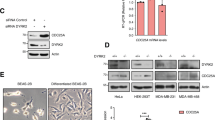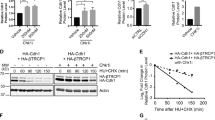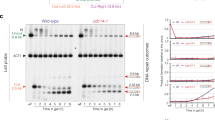Abstract
The Cdc25A phosphatase is essential for cell-cycle progression because of its function in dephosphorylating cyclin-dependent kinases. In response to DNA damage or stalled replication, the ATM and ATR protein kinases activate the checkpoint kinases Chk1 and Chk2, which leads to hyperphosphorylation of Cdc25A1,2,3. These events stimulate the ubiquitin-mediated proteolysis of Cdc25A1,4,5 and contribute to delaying cell-cycle progression, thereby preventing genomic instability1,2,3,4,5,6,7. Here we report that β-TrCP is the F-box protein that targets phosphorylated Cdc25A for degradation by the Skp1/Cul1/F-box protein complex. Downregulation of β-TrCP1 and β-TrCP2 expression by short interfering RNAs causes an accumulation of Cdc25A in cells progressing through S phase and prevents the degradation of Cdc25A induced by ionizing radiation, indicating that β-TrCP may function in the intra-S-phase checkpoint. Consistent with this hypothesis, suppression of β-TrCP expression results in radioresistant DNA synthesis in response to DNA damage—a phenotype indicative of a defect in the intra-S-phase checkpoint that is associated with an inability to regulate Cdc25A properly. Our results show that β-TrCP has a crucial role in mediating the response to DNA damage through Cdc25A degradation.
This is a preview of subscription content, access via your institution
Access options
Subscribe to this journal
Receive 51 print issues and online access
$199.00 per year
only $3.90 per issue
Buy this article
- Purchase on Springer Link
- Instant access to full article PDF
Prices may be subject to local taxes which are calculated during checkout




Similar content being viewed by others
References
Falck, J., Mailand, N., Syljuasen, R. G., Bartek, J. & Lukas, J. The ATM–Chk2–Cdc25A checkpoint pathway guards against radioresistant DNA synthesis. Nature 410, 842–847 (2001)
Zhao, H., Watkins, J. L. & Piwnica-Worms, H. Disruption of the checkpoint kinase 1/cell division cycle 25A pathway abrogates ionizing radiation-induced S and G2 checkpoints. Proc. Natl Acad. Sci. USA 99, 14795–14800 (2002)
Sorensen, C. S. et al. Chk1 regulates the S phase checkpoint by coupling the physiological turnover and ionizing radiation-induced accelerated proteolysis of Cdc25A. Cancer Cell 3, 247–258 (2003)
Mailand, N. et al. Rapid destruction of human Cdc25A in response to DNA damage. Science 288, 1425–1429 (2000)
Molinari, M., Mercurio, C., Dominguez, J., Goubin, F. & Draetta, G. F. Human Cdc25 A inactivation in response to S phase inhibition and its role in preventing premature mitosis. EMBO Rep. 1, 71–79 (2000)
Bartek, J. & Lukas, J. Mammalian G1- and S-phase checkpoints in response to DNA damage. Curr. Opin. Cell Biol. 13, 738–747 (2001)
Falck, J., Petrini, J. H., Williams, B. R., Lukas, J. & Bartek, J. The DNA damage-dependent intra-S phase checkpoint is regulated by parallel pathways. Nature Genet. 30, 290–294 (2002)
Donzelli, M. et al. Dual mode of degradation of Cdc25A phosphatase. EMBO J. 21, 4875–4884 (2002)
Jackson, P. K. & Eldridge, A. G. The SCF ubiquitin ligase: an extended look. Mol. Cell 9, 923–925 (2002)
Patton, E. E., Willems, A. R. & Tyers, M. Combinatorial control in ubiquitin-dependent proteolysis: don't Skp the F-box hypothesis. Trends Genet. 14, 236–243 (1998)
Spruck, C. H. & Strohmaier, H. M. Seek and destroy: SCF ubiquitin ligases in mammalian cell cycle control. Cell Cycle 1, 250–254 (2002)
Cenciarelli, C. et al. Identification of a family of human F-box proteins. Curr. Biol. 9, 1177–1179 (1999)
Kipreos, E. T. & Pagano, M. The F-box protein family. Genome Biol. 1, Reviews3002.1–3002.7 [online] 〈http://genomebiology.com/2000/1/5/reviews/3002〉 (2000)
Yaron, A. et al. Identification of the receptor component of the IκBα-ubiquitin ligase. Nature 396, 590–594 (1998)
Winston, J. T. et al. The SCF β-TRCP–ubiquitin ligase complex associates specifically with phosphorylated destruction motifs in IκBα and β-catenin and stimulates IκBα ubiquitination in vitro. Genes Dev. 13, 270–283 (1999)
Lassot, I. et al. ATF4 degradation relies on a phosphorylation-dependent interaction with the SCFβTrCP ubiquitin ligase. Mol. Cell. Biol. 21, 2192–2202 (2001)
Lang, V. et al. βTrCP-mediated proteolysis of NF-κB1 p105 requires phosphorylation of p105 serines 927 and 932. Mol. Cell. Biol. 23, 402–413 (2003)
Liu, C. et al. Control of β-catenin phosphorylation/degradation by a dual-kinase mechanism. Cell 108, 837–847 (2002)
Guardavaccaro, D. et al. Control of meiotic and mitotic progression by the F box protein β-Trcp1 in vivo. Dev. Cell 4, 799–812 (2003)
Margottin-Goguet, F. et al. Prophase destruction of Emi1 by the SCFβTrCP/Slimb ubiquitin ligase activates the anaphase promoting complex to allow progression beyond prometaphase. Dev. Cell 4, 813–826 (2003)
Hsu, J. Y., Reimann, J. D., Sorensen, C. S., Lukas, J. & Jackson, P. K. E2F-dependent accumulation of hEmi1 regulates S phase entry by inhibiting APCCdh1. Nature Cell Biol. 4, 358–366 (2002)
Painter, R. B. & Young, B. R. Radiosensitivity in ataxia-telangiectasia: a new explanation. Proc. Natl Acad. Sci. USA 77, 7315–7317 (1980)
Verma, R. et al. Phosphorylation of Sic1p by G1 Cdk required for its degradation and entry into S phase. Science 278, 455–460 (1997)
Nash, P. et al. Multisite phosphorylation of a CDK inhibitor sets a threshold for the onset of DNA replication. Nature 414, 514–521 (2001)
Wu, G. et al. Structure of a β-TrCP1–Skp1–β-catenin complex: destruction motif binding and lysine specificity of the SCFβ-TrCP1 ubiquitin ligase. Mol. Cell 11, 1445–1456 (2003)
Clucas, C., Cabello, J., Bussing, I., Schnabel, R. & Johnstone, I. L. Oncogenic potential of a C. elegans cdc25 gene is demonstrated by a gain-of-function allele. EMBO J. 21, 665–674 (2002)
Bell, D. W. et al. Heterozygous germ line hCHK2 mutations in Li–Fraumeni syndrome. Science 286, 2528–2531 (1999)
Carrano, A. C., Eytan, E., Hershko, A. & Pagano, M. SKP2 is required for ubiquitin-mediated degradation of the CDK inhibitor p27. Nature Cell Biol. 1, 193–199 (1999)
Acknowledgements
We thank T. K. Ko for his contribution; Z. G. Pan and S. Reed for reagents; G. Ossolengo for producing and purifying the anti-phosphoS82/S88 antibody; and M. Squatrito and E. De Billy for discussion. This work was supported by an Italian American Cancer Foundation fellowship and a Susan Komen Breast Cancer Foundation fellowship to D.G.; a Irma Hirschl Scholarship and grants from the NIH to M.P.; and grants from the Italian Association for Cancer Research (AIRC), the Italian Foundation for Cancer Research (FIRC) and Telethon to G.F.D.
Author information
Authors and Affiliations
Corresponding author
Ethics declarations
Competing interests
The authors declare that they have no competing financial interests.
Rights and permissions
About this article
Cite this article
Busino, L., Donzelli, M., Chiesa, M. et al. Degradation of Cdc25A by β-TrCP during S phase and in response to DNA damage. Nature 426, 87–91 (2003). https://doi.org/10.1038/nature02082
Received:
Accepted:
Issue Date:
DOI: https://doi.org/10.1038/nature02082
This article is cited by
-
ZNF827 is a single-stranded DNA binding protein that regulates the ATR-CHK1 DNA damage response pathway
Nature Communications (2024)
-
Cyclers’ kinases in cell division: from molecules to cancer therapy
Cell Death & Differentiation (2023)
-
Inhibitors Targeting the F-BOX Proteins
Cell Biochemistry and Biophysics (2023)
-
HPV-mediated regulation of SMAD4 modulates the DNA damage response in head and neck cancer
Journal of Experimental & Clinical Cancer Research (2022)
-
A novel CDC25A/DYRK2 regulatory switch modulates cell cycle and survival
Cell Death & Differentiation (2022)
Comments
By submitting a comment you agree to abide by our Terms and Community Guidelines. If you find something abusive or that does not comply with our terms or guidelines please flag it as inappropriate.



